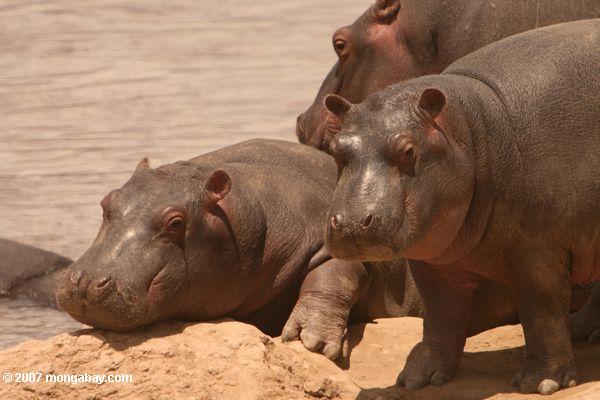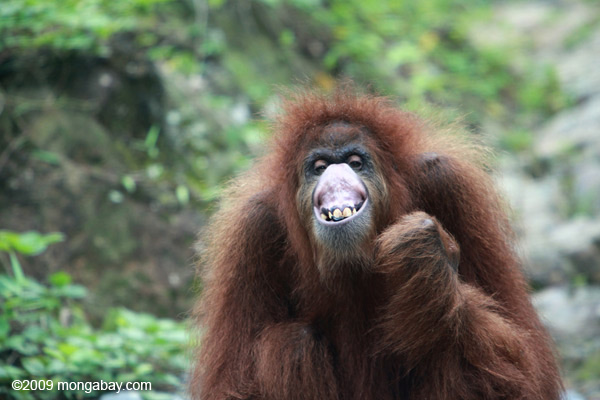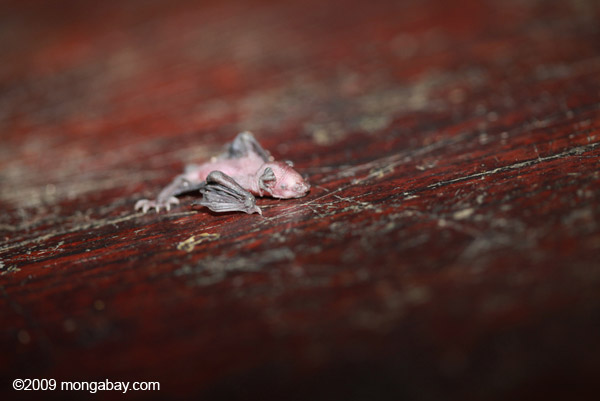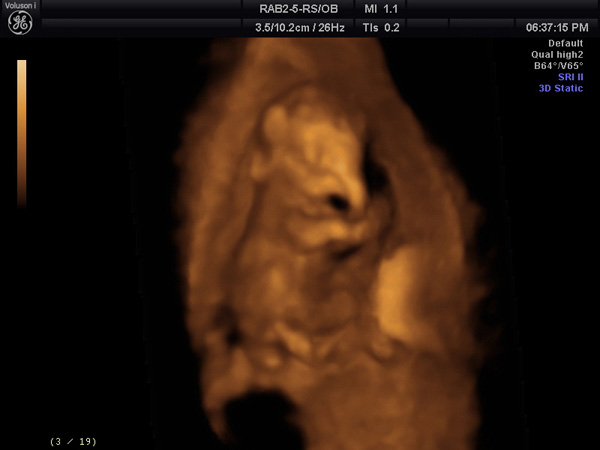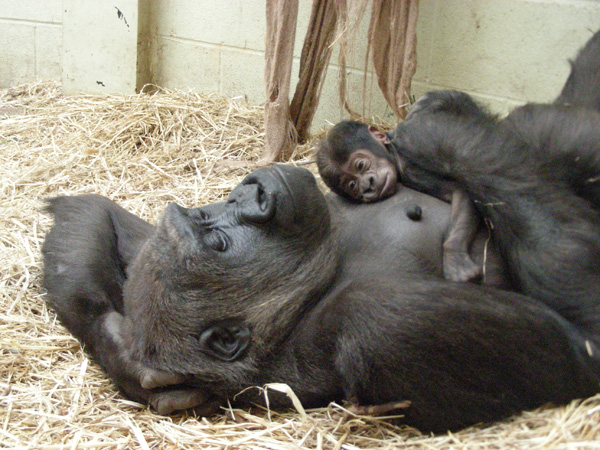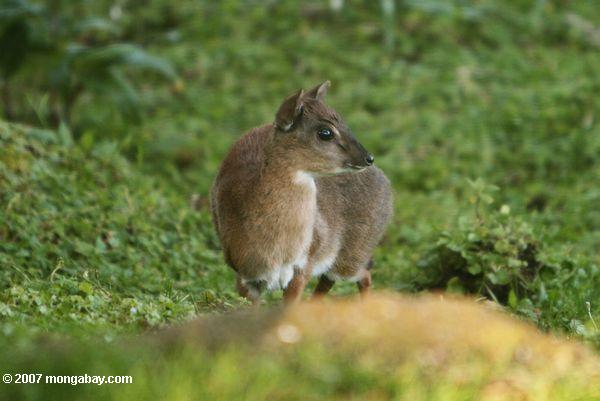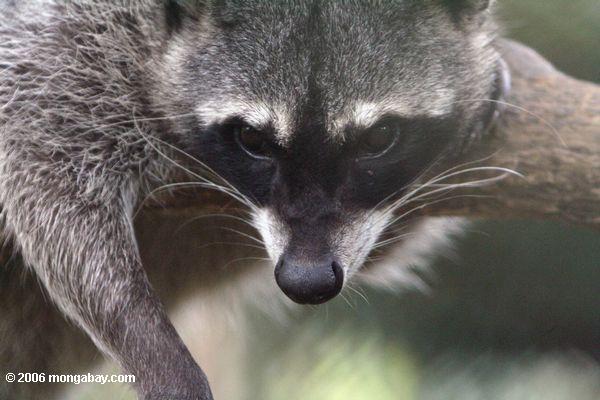Video: lemur evolution
From the Science Channel show Mutant Planet, this episode on Madagascar looks at the bizarre turns evolution takes on one of the world’s most unique islands. To find out more information and see more videos from the production: Mutant Planet:...
Photo: young hippos
Young hippos in Kenya. Photo by: Rhett A. Butler. Click to see more photos of hippos.
Pictures: Baby kinkajou
Baby kinkajou at Proyecto Asis rehabilitation center in Costa Rica
“The Last Lions” trailer
Opening on February 18th, The Last Lions, a National Geographic film, follows a lioness and her two cubs’ dramatic journey of survival in the Okavango Delta of Botswana. Through the lions’ story the film addresses the catastrophic decline in lion populations across the continent, which have fallen from 450,000 to some 20,000 over the past 50 years. Shooting took place in Botswana over 7 years by veteran filmmakers Dereck...
Picture: Arctic musk oxen in defensive posture
The musk ox was extinct in Alaska as recently as the 1880s but was re-introduced into Alaska’s Arctic in the 1970s and today, approximately 3500-4000 musk oxen exist there. According to Joel Berger, a conservationist at the Wildlife Conservation Society (WCS), says that only 10-30 of the animals remain in Alaska’s Arctic National Wildlife Refuge–down from more than 400 that lived in the refuge in the 1990s.
What a face!
A Sumatran orangutan (Pongo abelii) makes a face. Listed as Critically Endangered the Sumatran orangutan is largely threatened by habitat loss to plantations, such as wood pulp and palm oil, and logging. After losing their forests, many orangutans, such as this one, are now housed in rehabilitation centers. Photo by: Rhett A. Butler. Click to see more photos of...
Hairy elephant-relative with baby
This bizarre animal, resembling a rodent, in Kenya is a southern tree hyrax (Dendrohyrax arboreus). Although the size of rabbit, the hyrax is actually closely related to the elephant and belongs to the Afrotheria clade that includes not only elephants, but manatees, sengis, tenrecs, and aardvarks. Four species of hyrax survive today. Photo by: Rhett A. Butler. Click to see more photos of...
Rarely seen: a baby bat
A baby bat, referred to as a pup, in Brazil. Photo by: Rhett A. Butler. Click to see more photos of this bat pup.
Elephant pair at the Chobe River
As the day ends numerous herds of Africa elephants (Loxodonta africana) come down to the Chobe River to drink and socialize. African elephants are listed as Vulnerable by the IUCN Red List. They are threatened by habitat loss, poaching, and human-elephant conflict. On the positive side, African elephant populations are viewed as increasing on the continent. Photo by: Tiffany Roufs. Click to see more photos of...
Orphaned baby sloth
Orphaned baby three-toed sloth in the village of the Trio indigenous tribe in Suriname. The sloth was clinging to a stuffed panda bear. Photo by: Rhett A. Butler. Click to see more photos of the baby...
Elephant in utero
Just 3 months into development, this image captures a rare look at a male Asian elephant in utero: showing off already its telltale trunk and big ears. Elephant mothers spend 22 months in pregnancy before giving birth. The elephant photographer here, named George, is now 6 months old and doing well. Asian elephants are classified as Endangered by the IUCN Red List. They are threatened by habitat loss, poaching, and human and wildlife...
Camel and government-built yurts
A camel stands in front of government-built yurts near Lake Karakul in the Xinjiang Province of north-western China. Photo by: Rhett A. Butler . Click to see more photos from Lake...
Rehabilitating a kinkajou
A kinkajou (Potos flavus)–also known as a honey bear or cat monkey–being rehabilitated in Costa Rica. Despite it’s many creative monikers, the kinkajou is most closely related to raccoons and coatis in the eclectic and omnivorous Procyonidae family. The kinkajou is classified as Least Concern by the IUCN Red List, although it is thought the population, which spreads from Central to South America, is in decline. Photo...
Gorilla born at the London Zoo
Mjukuu with her new baby boy. Photo courtesy of the Zoological Society of London (ZSL) . On October 26th, the London Zoo received a new arrival: a baby western lowland gorilla. The as yet unnamed boy was born to first-time mother Mjukuu. Zoological director, David Field, said the pair were doing ‘brilliantly’. Classified by the IUCN Red List as Critically Endangered, western lowland gorillas, a subspecies of lowland...
Small antelope on Mount Kenya
A Suni (Neotragus moschatus), a small East African antelope, photographed on a trek up Mount Kenya. Photo by Rhett A. Butler, 2007. To see more photos of Mount Kenya.
New Borneo photos on mongabay.com
Mongabay.com has added new photos from Sabah, Malaysian Borneo including wildlife, palm oil plantations, and landscapes. One of the few surviving Critically-Endangered Bornean rhinoceros. Known as Tam, conservationists hope a female can be found for this captive male in order to help save the species. Photo by Jeremy Hance, 2009. Sunset over the rainforest at Tabin National Park. Photo by Jeremy Hance, 2009. Palm oil plantations as...
Up-close with a crab-eating raccoon
A crab-eating raccoon (Procyon cancrivorous) in Panama. Photo by Rhett A. Butler, 2007. Up-close and personal with a crab-eating raccoon in Soberania National Park in Panama. Shorter fur than the common raccoon makes it look smaller. The crab-eating raccoon is not threatened. To see more photos of mammals in...

